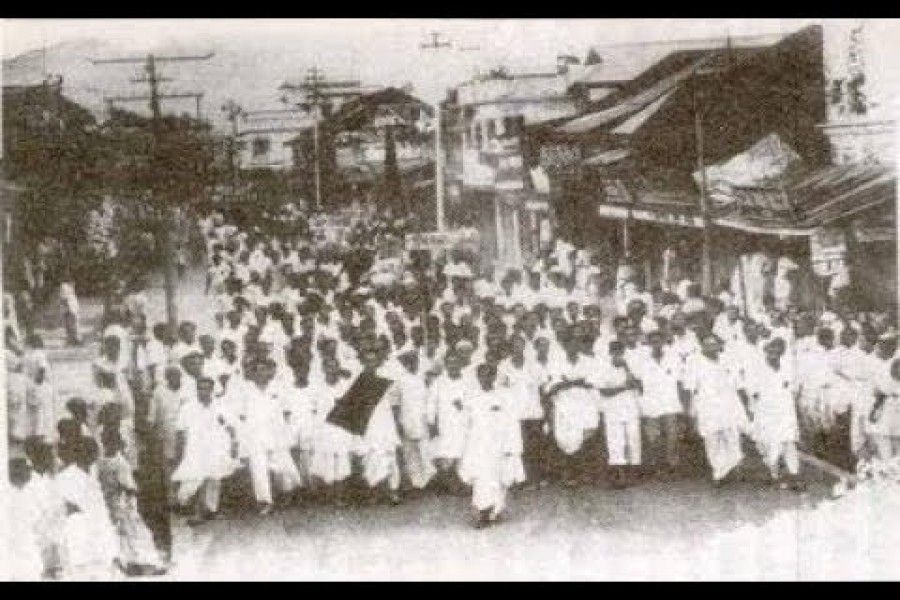The people of then East Pakistan are not the only ones to take a stand for their mother tongue.
Bangalees all over the subcontinent had struggled against various linguistic invasions over their mother tongue, and every time they had risen up in protest.
Since the partition, they have struggled for their mother tongue in Assam, Jharkhand, Bihar, Chhattisgarh, Delhi and Karnataka.
Those movements in different countries and in different setups are significant for their stance on language.
Barak Valley, Assam
The proposal to declare Assamese as the one and only official language of the state was raised on the Assam Pradesh Congress Committee in April 1960.
Later in 1960, the Chief Minister of Assam tried to legalise Assamese as the only state language, to which the Bengali legislators vehemently opposed, citing the bill as an oppression of the minority over the majority Bengali people. Yet, the bill was passed.
In response, the ‘Cachar Gana Sangram Parishad’ was formed in protest on February 5, 1961.
The Bengali majority three districts of Barak Valley - Silchar, Karimganj and Halakandi started protesting against the injustice of the Assamese government.
The protest escalated and the protesters gave an ultimatum to make Bengali an official language, non-compliance to which would lead to a state-wide hartal.
In May, three leaders of the movement were arrested. On the next day, the hartal was successful, and the military arrested nine protesters. In response, the crowd erupted into a protest, and the military opened fire, killing 11 protesters.
After the incident, the Assam government had to withdraw the circular and Bengali was ultimately given official status in the three districts of Barak Valley, declaring -
“Without prejudice to the provisions contained in Section 3, the Bengali language shall be used for administrative and other official purposes up to and including district level.”
Every year, 19 May is celebrated as the Bhasha Shaeed Dibash in the Barak Valley.
Manbhum, Bihar
The first and the longest language movement of India was the Bangla language movement of the Manbhum district of Bihar (now Purulia of West Bengal).
After the partition, Manbhum became part of Bihar, despite being a Bengali majority region. Having transferred all the Bengali officers from Manbhum to other parts of Bihar, the Bihar State Authority declared that Hindi would be the only official language of Manbhum.
The declaration was enforced with utmost pressure by closing the Bangla Department in the Zilla School and installing Hindi signboards in all education and business institutions, removing the Bangla ones.
A proposal to make Bangla the language of Manbhum district was defeated in the Congress Party on May 30, 1948; the use of Bangla was restricted to only a few limited spaces.
As a reaction, the ‘Lok Sevak Sangha’ was created on June 14 to prevent the forcible imposition of Hindi over the Bengali-speaking people. The Sangha adopted the policy of Satyagraha - the Gandhian way of peaceful protest.
The Bihar state government let loose repression by banning rallies, etc. This culminated in a fierce protest throughout the length and breadth of Manbhum district. The protest gained more steam when a plan to merge Bihar with West Bengal to create a single state was proposed.
On April 20, 1948, a team of 1005 Satyagraha protesters began a march from Manbhum to Kolkata, chanting songs like - ‘Bande Matram,’ ‘Banglar Mati Banglar Jol,’ ‘Bangla Praner Bhasha re’ etc.
The protesters reached Kolkata on May 6, after marching 300 kilometres, where the police arrested 956 protesters.
The movement gained momentum afterwards, and a commission named ‘State Re-Organization Commission’ was formed by the Central government. The Commission held hearings in Manbhum district and submitted its report, proposing the formation of a new district ‘Purulia’ with the police stations primarily dominated by Bengali speaking people to West Bengal from erstwhile Manbhum district of Bihar.
On 1 November 1956 with 16 Police stations, 2007 square mile area and with a population of 1,169,097 the new district Purulia was acceded to West Bengal, bringing the longest language movement to a successful end.
Karnataka
In Karnataka, many Bengali refugees took shelter in various villages, where there was no provision for them to read Bangla, even though the state housed nearly a million Bengali.
After much protest, on May 19, 2013, Karnataka government included Bangla as the second language in which kids can complete their education. Now there are more than 100 Bangla medium schools in Karnataka and most of the Karnataka board schools offer Bangla as a second language.
There had been such protests by the Bengali refugees in Chhattisgarh, Delhi and Jharkhand. However, the movement did not reach its fruition.
On the eve of International Mother Language Day, the Bangalee all over the world should commemorate the valiant efforts of Bangalee all over the sub-continent to protect the honour and right of their precious mother tongue.
shadique.mahbub.islam@gmail.com


